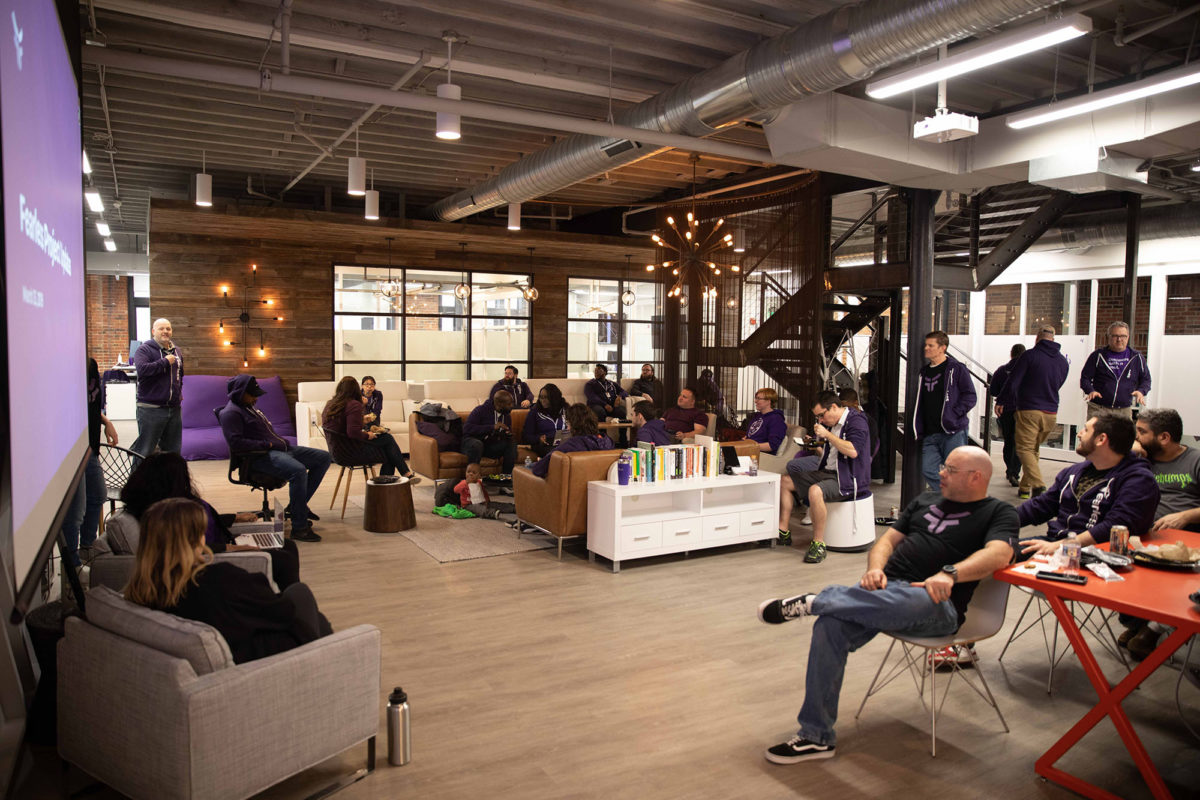Being around passionate people and joining a well-defined culture were among the main reasons that Jesse James sought a job with Fearless.
“They put their culture first, and I think that’s important,” the UX designer said of the downtown software shop. “It’s not what we do, it’s how we do it — that’s what gets us out of bed in the morning.”
That culture comes through as new employees join the company, from in-person lunches to delivering a welcome bag that includes company gear and Seth Godin’s book “Purple Cow,” a touchstone for the company.
Normally that’s all done face-to-face, but now that in-person exchange isn’t an option as businesses are shifting to remote work amid social distancing measures to limit the spread of COVID-19.
But when James started last week, the connecting points and swag were part of the first day — just by mail and by Zoom.
The shift to remote work that came about over the last two weeks brought changes to hiring and onboarding at companies that are continuing to grow their teams. With digital tools and a bit of creativity, companies don’t have to abandon parts of the process that were carefully constructed to give a warm welcome and reflect the company.
“We’re trying our best to keep our culture the same as much as possible,” said HR business partner Amber Kyler.
At Fearless, hiring plans that were put in place before the pandemic remain full steam ahead. So, like other parts of work, things must continue even if it’s a new setting.
The company’s interview process was previously split between remote and in-person interviews. Now it’s being conducted entirely via Zoom.
When it comes to the conversation itself, technical recruiter John Priest said it’s important to make sure the current reality during shifting times lines up with a candidate’s expectation of the role. Addressing the changes directly during the recruiting process helps to build as clear a picture as possible.
“Candidates respect the fact that we’re not forcing anyone to come into the office, and they also really respect the fact that we are still moving forward and we are looking at teammates’ health and well-being first and foremost,” Priest said.
At Canton software development consultancy SmartLogic, the team already worked from home on Mondays and Fridays, and had remote employees. As it seeks to hire software developers, the team is applying learnings from past remote hiring, said its content and digital marketing manger, Rose Burt. Most of the interview can remain the same in the transition to video call, but one key staple of all tech companies will have to be left aside.
“We’ll still have two of our engineers meet with the candidate, and they’ll discuss a specific architecture solution to a problem we present and then implement some of it,” Burt said. “The only substantial difference will be that when we do these in person, we use a whiteboard for the planning part of it. We don’t really have a digital alternative, so we make do without that for the remote interviews.”
For the interview itself, Director of Developer Operations Dan Ivovich emailed the following tips from his perspective:
- Make sure to set clear expectations.
- Have a clear agenda (which is the same way we’d handle in-person).
- Ask the candidate what video conferencing software works best for them.
- Don’t skip the casual chat you might normally start with in person.
Burt added that, for any remote interview, it’s best to conduct a group interview where everyone can be close to a camera. If a candidate is talking to a group who is sitting around a conference table, it can make it even tougher to read the room.
For the onboarding process, Kyler said Fearless was able to make a smooth transition when it came to the usual information transfer and documentation that comes with starting a new job. The company already had the key introductory materials online as digital assets, and used BambooHR for the human resources functions. There was even a virtual walkthrough of the office.
“All of our tools were set to be self-managed and work in a remote situation,” she said.
The company provides a laptop and the aforementioned welcome bag, so those are now mailed ahead of a candidate’s first day.
A big portion of the first day at Fearless also involves meeting the team. Typically, there’s a lunch with the team. Now, there’s a Grubhub gift certificate and a Zoom meeting over lunch. James said though it may sound awkward, he appreciated the chance to talk to the team.
The UX designer also got a greeting via Slack from CEO Delali Dzirasa and COO John Foster. In the near future, James is also scheduled to have lunch with Dzirasa — a tradition that company has had since it was just a handful of employees.
He appreciates the gesture, perhaps even a bit more in a time where there’s probably lots going on.
“Even though you’re remote,” James said, “that culture, if it’s deeply ingrained in the company, will still resonate.”
Before you go...
Please consider supporting Technical.ly to keep our independent journalism strong. Unlike most business-focused media outlets, we don’t have a paywall. Instead, we count on your personal and organizational support.
3 ways to support our work:- Contribute to the Journalism Fund. Charitable giving ensures our information remains free and accessible for residents to discover workforce programs and entrepreneurship pathways. This includes philanthropic grants and individual tax-deductible donations from readers like you.
- Use our Preferred Partners. Our directory of vetted providers offers high-quality recommendations for services our readers need, and each referral supports our journalism.
- Use our services. If you need entrepreneurs and tech leaders to buy your services, are seeking technologists to hire or want more professionals to know about your ecosystem, Technical.ly has the biggest and most engaged audience in the mid-Atlantic. We help companies tell their stories and answer big questions to meet and serve our community.
Join our growing Slack community
Join 5,000 tech professionals and entrepreneurs in our community Slack today!






